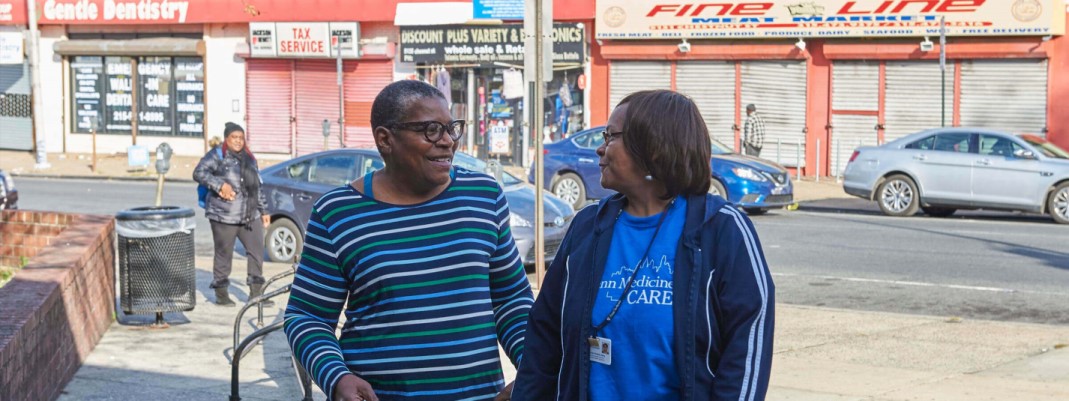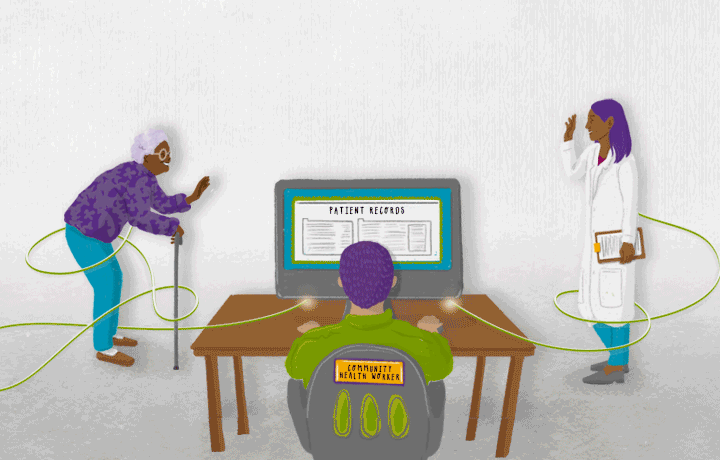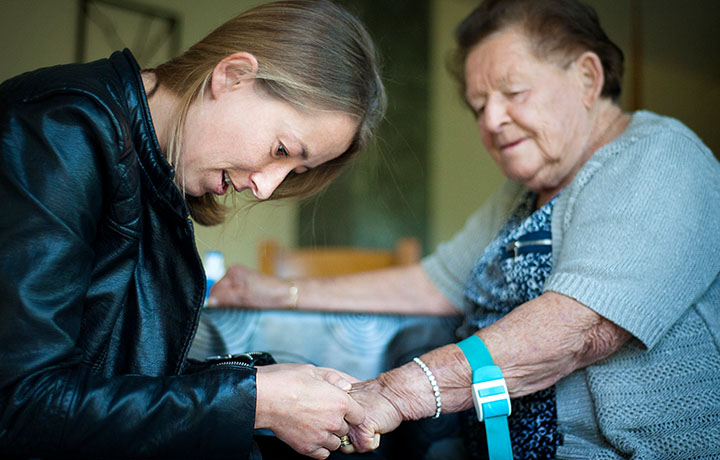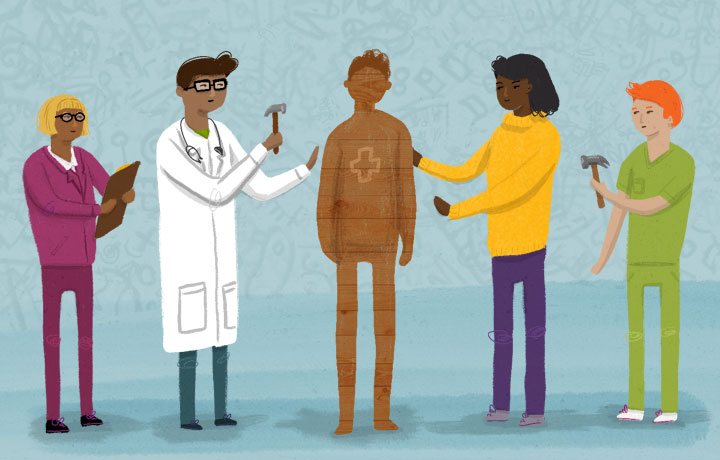Article
5 ways to optimize community health workers
By Lia Novotny | October 4, 2018

Shreya Kangovi, M.D., likes to tell the story of Mr. Brenner, a 50-year-old homeless man with a history of trauma, incarceration, and multiple suicide attempts.
Various medical staff seemed unable to connect meaningfully with him, until Brenner met Cheryl, a community health worker who asked not only about his medical ailments, but also when he had last laughed out loud.
That one question changed the course of Brenner's health. A trip with Cheryl to the bowling alley, where he'd last belly-laughed, led to a trusting relationship that helped Cheryl address his mental health and housing issues as well as make him feel seen and heard.
Replicating success
Kangovi, founding executive director of the Penn Center for Community Health Workers, doesn't tell the story just for its warm and fuzzy ending, but to emphasize both the power and precariousness of the community health worker movement.
"There are millions of Mr. Brenners out there," Kangovi says. "How do we know this [model] can work over and over again, so that it's not just a feel-good story?"
As the community health worker movement has gained steam at home and abroad, more and more healthcare organizations are exploring its potential to close care gaps, address social determinants of health, move care beyond the clinic walls, and lower costs. But they often struggle to scale and sustain early successes with a wider population over time.
That's why Penn has been working for more than a decade to bottle the CHW magic and replicate it consistently. Its Individualized Management for Patient-Centered Targets (IMPaCT) model addresses the pitfalls that so often plague CHW programs: staff turnover, lack of infrastructure, poor clinical integration, narrow disease focus, and low quality evidence of outcomes.
Penn's own 30 employed CHWs adhere to IMPaCT as they support 2,500 patients at a dozen locations throughout the Philadelphia area. Penn researchers conduct rigorous studies on their own and other CHW programs to understand what makes them work. And they share the results and the complete IMPaCT toolkit with any interested organizations – about 1,000 so far.
Based on Penn's research and experience, Kangovi shares five key program elements necessary to create a successful CHW program with a demonstrable return on investment.
1. Hire the right people
“Community health worker interventions are only as good as the folks hired to do the job," says Kangovi. First, it's crucial that CHWs have similar education, income, race, and ethnicity to the patients they are serving. Mr. Brenner would likely not have connected with Cheryl if she hadn't hadn't faced some of the same challenges or already known his bowling alley.
For those reasons, Penn de-emphasizes paper resumes and textbook qualifications, looking instead for interpersonal skills, absence of prejudice, and a tendency to listen more than talk. Screening may include role-playing or theoretical case scenarios to tease out these skills.
Often the search means bypassing traditional job sites and listings in favor of working with parent-teacher organizations, soup kitchens, and other community organizations to find "natural helpers." The result has been a turnover of around 2 percent among Penn's community health workers, compared to rates as high as 50 percent in other programs.
2. Train and support community health workers – and everyone around them
IMPaCT provides detailed work practice manuals for CHWs, supervisors, and program directors, each tailored by strategic scope. For example, the CHW manual has an interview guide for when health workers first meet with a patient – and yes, Cheryl's question to Mr. Brenner about laughter is included as a talking point.
Supervisor manuals focus on ways to work productively with clinical teams and keep CHWs safe in the field. CHW supervisors are urged to track workflows, patient-specific goals, quality reporting, and performance assessments, whereas the director manual focuses on how to build a cost-savings model and track outcomes.
3. Design programs around patients, not diseases
In healthcare, clinicians are used to "telling patients what they need," says Kangovi. “We seldom ask, 'What do you think you need to improve your health?'"
When asked, patients tend to talk about the upstream drivers of health, such as housing, work, food, money for medical supplies – or just a reason to get out of bed in the morning.
These needs aren't limited to a single disease, which is why building disease-specific CHW interventions will never be as effective, Kangovi says. IMPaCT CHWs refer patients to food pantries and housing agencies, of course, but they go further — to the bowling alley, for example.
And CHWs work with patients to come up with creative, granular solutions that basic referral or telephone screening programs could never propose. "Waitlists at the public housing authority are seven or eight years long," says Kangovi, "so our community health worker will say, 'Who do you know who will let you crash for a while? How can we get you reconnected with your estranged sister?" And CHWs accompany patients to the housing agency to help them sign up for benefits or to translate.
"This kind of 'instrumental support' is about doing something with and for the patient, not just telling them about government or funded programs that may or may not be out of reach," Kangovi says.
4. Integrate CHWs into the clinical setting – but not too much
Under the IMPaCT model, CHWs have only one or two hospitals or clinics assigned as their "clinical homes," where they work closely with the care teams. These are typically the clinics with the most at-risk patients.
The CHWs accept referrals from the clinic physicians, and also independently review census data to identify eligible patients, entering their notes into Penn's custom software that integrates with the clinic's EHR. Additionally, health workers reach out to physicians in-person or by phone to share what they have learned from each patient encounter.
The clinical home is where CHWs gather and report clinical data on their patients. Beyond that, they report to a centralized supervisor and meet regularly with a team of other CHWs, which helps them stay focused on the whole patient. Because, as Kangovi notes, “you don't want them to be so medicalized that you have lost their community identity."
5. Base interventions on high-quality evidence
Penn has been rigorous in studying the effect of CHW interventions on patient outcomes and cost. In a 2017 randomized trial, patients receiving CHW support showed modest improvements in managing diabetes, obesity, and smoking.
Patients receiving CHW support reported significantly higher satisfaction with their primary care and how it supports self-management of chronic conditions (63 percent said they could self-manage vs. 38 percent in the control group). Supporting the business case for CHWs, the study also showed an 18.5 percent reduction in hospitalizations in a 6-month period for those patients with a community health worker – and the effect grew to almost 30 percent six months later, even after the program ended.
And so, according to Kangovi, “if a program is implemented the right way, there's a case for financial sustainability, and you can afford to do things like pay your team fairly and build in the infrastructure that we're talking about, because of the reductions in hospital utilization and the improvements in quality and health."
Keeping the magic going
All five of these program elements enable CHWs to address patients' real-life needs, which have not always been the domain of traditional healthcare. And, according to Kangovi, “addressing patients' needs is about putting people on the ground, working with them day after day – that's really what patients have told us that they value the most."
And at Penn, it's the way they bolster the aspirational potential of CHWs with real-world processes that keep the magic going.
Lia Novotny is a contributing writer to athenaInsight.







